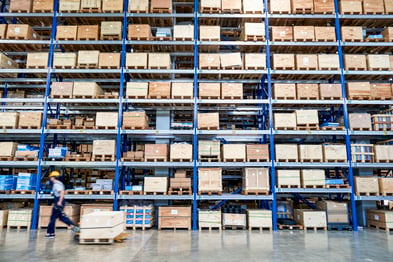The ‘always open’ store is here to stay as eCommerce continues to dominate retail. But what are the new demands placed on warehouses and how can technology help them adapt quickly without compromising costs and employee safety?

Covid’s impact on retail in the last year has been undeniable, resulting in a dramatic drop in footfall and high street shops being forced to close their doors. eCommerce claimed centre stage and shows no signs of slowing as we head into spring and summer and watch the world reopen. With this explosive increase in demand, behind the scenes there’s a growing movement that’s transcended from a trend to an operational necessity. That is, the adoption of 24-hour warehousing.
Retail will never be the same
Consumer habits have changed and many of them won’t be changing back. Reports show that 82% of consumers will continue to shop online rather than visiting stores even after the pandemic has eased. With this, expectations have also changed. Generations who may not have been versed in online shopping have adapted and taken it in their stride. Next day or even same day delivery have become the norm and both individuals and businesses expect to get goods in their hands more flexibly and often at low to no delivery costs.
Taking full advantage of technology such as data analytics and automation can help warehouses meet the call for streamlined operations aligned with rising expectations, while transforming the way the industry works.
Technology never sleeps
Always up and running, machines can meet surging demands without slowing down. Investing in mechanisation leaves warehouse operations less dependent on labour and therefore more efficient. These automated warehousing solutions are becoming increasingly sophisticated, from loading and unloading systems that can swerve obstacles and take alternative routes without assistance to robotics that take care of the sorting tasks. What’s more, data analytics are enabling greater visibility and management of inventory of stock levels and devices such as drones can be employed for inventory surveillance.
Improved operations not only create cost savings and scalability, but they also crucially empower the role of the workforce. Backed by resilient and efficient technology, workers are liberated from manual tasks and able to add their service value. As the supply chain adapts to demand, more skilled jobs are becoming available with the industry hunting quick-thinking people to tackle upcoming manufacturing and logistics challenges while harnessing the latest innovations. In the UK alone, Amazon is seeking to recruit 7,000 professionals in supply chain this year to help them stay ahead. The company has three new fulfilment centres in the pipeline where workers will team up with robots to complete orders.

The race for space
The need for retailers to expand their online offering has sky-rocketed demand for warehouse space. Rightmove recorded a record number of enquiries for industrial and warehousing space, surging by 108% in January this year compared to January 2020. Making the most of existing space has never been so important for businesses needing to equip themselves to take on future distribution and fulfilment challenges without splurging on bigger warehouses.
Sustainable technology can maximise their space for example, with tools such as automatic channel baling presses that take waste packaging materials and compact them into bales to free up valuable space for warehousing processes. Moreover, making processes more sustainable powers return on investment and reduces the amount of electricity needed to power operations. Doing more with less space, money and energy, technology can support the practical considerations of running 24-hour warehouses in existing buildings.
On the flip side, locations that weren’t traditionally considered for warehouses have grown in popularity as they can provide the power needed to accommodate advanced technology. Retailers are fitting out their warehouses with sensors and robotics to stay ahead with the accelerated delivery pace to consumer. This energy availability gives warehouses the edge, realising automation at scale and bringing businesses ever closer to the end consumer.
The people behind the parcels
‘Always open’ stores can’t be credited to technology alone - warehouse and logistics workers have made them possible. Ensuring shelves are well stocked and rapidly responding to the spike in online sales, they’re the key workers who have become heroes in their own right.
Technology can empower them with improved processes, but completely autonomous deliveries are a long way off. That’s why supporting workers’ roles in 24-hour warehousing is crucial for keeping up momentum and seamlessly adapting to demands. Software can be used to keep workforce job satisfaction, safety and ultimately productivity at its peak. Employee scheduling software manages shift patterns, ensures workers receive a break and lifts the burden of managing shifts manually for managers. Utilising predictive labour optimisation, it can determine how many people are needed and at which time of the day they’re required. This dramatically simplifies the continuation of always-in-motion service, saves costs and – most important – improves the safety of operations.
The future is non-stop retail
24/7 warehousing is addressing today’s rapidly evolving retail landscape with the help of technology. CDW is here to help retailers understand, embrace and implement smart solutions to make a real difference to staff productivity and morale, as well as to customer experience and the bottom line. If you’d like to hear about how we can get you up and running with non-stop shopping, we’d love to hear from you.

Jane Liston - Retail Sales Lead, CDW
For any enquiries contact: info@uk.cdw.com | 020 7791 6000
